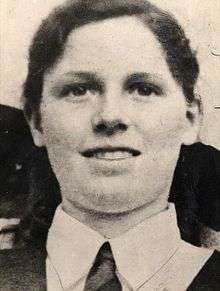Murder of Muriel Drinkwater
| Muriel Drinkwater | |
|---|---|
 | |
| Born |
Muriel Joan Drinkwater July to September 1933 Carmarthen, Carmarthenshire, Wales |
| Died |
27 June 1946 (12 years) Penllergaer, Swansea, Wales |
| Cause of death | gunshot and head injury |
| Parent(s) | Percival and Margaret Drinkwater |
The murder of Muriel Drinkwater is an unsolved 1946 child murder case from Wales. Drinkwater, a 12-year-old schoolgirl, was raped and shot in the woods in Penllergaer, Swansea. The case became known as the Little Red Riding Hood murder. In 2008, a DNA profile of the suspect was extracted from her clothes, possibly the oldest one in the world to be successfully extracted in a murder investigation.[1]
Murder and investigation
Muriel Joan Drinkwater was the youngest of four daughters to John Percival and Margaret (née Morgans) Drinkwater.[2] On 27 June 1946, she took the school bus home from Penllergaer Grammar School. She was last seen at 2:30 p.m., singing as she headed for the one-mile walk to her family's home, Tyle-Du Farm. The path she walked home on curved in and out of the woods; her mother saw her walking home along the path and go into the woods, but not come out again. The last person to see her was Hubert Hoyles, then 13, who passed her on the path returning from her family farm, where he had gone to buy eggs.[3] Her mother later went to the village to look for her when she did not return home; more than a dozen men from the area began a search.[4]
The next day, Drinkwater's body was found in the woods by a police inspector. She had been raped and shot twice in the chest, and beaten in the head. Two days later, police found the murder weapon, a World War I-era Colt .45 weapon.[5][1]
Detectives from Scotland Yard came to Swansea to assist in the investigation of the murder, among a rash of slayings of women during the time.[6] The police visited every house within 150 square miles, and interviewed 20,000 men in Swansea and neighbouring Aberdare and Carmarthenshire.[5]
More than 3,000 mourners attended Drinkwater's funeral on 2 July. She was buried at St David's Church in Penllergaer.[5][1]
A description of a person of interest was circulated; he was described as approximately 30 years old, with "thick fluffy hair and wearing brown corduroy trousers and a light brown sports jacket."[1]
Police also circulated photos of the American army issue gun; notably, perspex has been used to modernise the original wooden stocks next to the grip. It was believed a similar weapon had been used in the murder of a cinema manager in Bristol. In August, the police appealed to the United States public for assistance, as many Americans had been stationed in Penllergaer during the recent war and there was a possibility one of the servicemen had sold the weapon.[1]
DNA discovery
In 2003, detectives re-opened the case in the hope of finding DNA evidence on the gun, but were not successful as too many people had handled the gun. Her clothes appeared to have been lost.[4]
In 2008, a team of retired detectives investigating cold cases found Drinkwater's clothes in storage. Her blue coat, her underwear and school uniform had been wrapped in a paper bag and stored. On the back of the coat, a no-longer visible semen stain was circled with yellow crayon.[5] Scientists successfully retrieved a DNA profile from the stain on the coat. A familial DNA profile was extracted using a technique called Y-STR, but no match was found in the national DNA database.[7] Hubert Hoyles, who was the last person to see her alive after buying eggs at her parent's farm, was cleared by the DNA evidence. He stated he had long been suspected by some locals as the murderer and was happy to clear his name.[3]
Public access
In 2010, the Lord Chancellor's Advisory Council on National Records and Archives closed off public access to the case. The public can no longer access the Drinkwater files by Freedom of Information Act requests or in person at the archives office in Kew. The reason given for sealing the files was that it could help the police catch the perpetrator.[5]
See also
- Murder of Lynette White, 1988 murder of Welsh girl solved by DNA in 2002
References
- 1 2 3 4 5 Gabriel, Clare (5 November 2008). "Mystery of 1946 murder in woods". BBC News. Retrieved 17 September 2016.
- ↑ Turner, Robin (6 November 2008). "Hunt on for 80-year-old Swansea killer". Wales Online. Retrieved 17 September 2016.
- 1 2 Davies, Barbara (7 November 2008). "Real waking the dead: This schoolgirl's savage murder has mystified police for 62 years. Now cutting-edge forensics to rival any TV thriller have identified her killer's DNA". The Daily Mail. Retrieved 17 September 2016.
- 1 2 Gill, Charlotte (5 November 2008). "DNA breakthrough could solve Britain's oldest murder case". The Daily Mail. Retrieved 17 September 2016.
- 1 2 3 4 5 Turner, Robin (31 March 2010). "Secrecy over 1940 murder as DNA offers new leads". Wales Online. Retrieved 17 September 2016.
- ↑ "Serial Slaying of Pretty Women Has New Scotland Yard Confused". The Montreal Gazette. Associated Press. 29 July 1946. Retrieved 17 September 2016.
- ↑ "DNA breakthrough on 1946 murder". BBC News. 4 November 2008. Retrieved 17 September 2016.